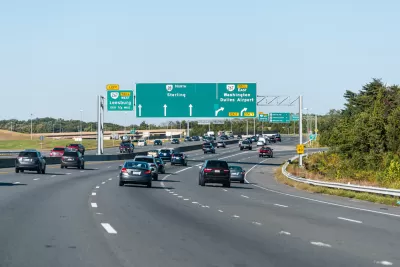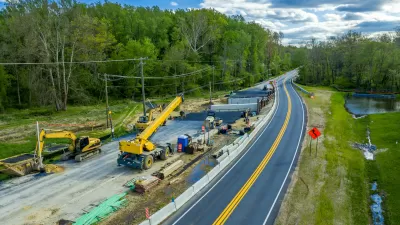The Northern Virginia Transportation Authority’s plans to widen and expand the region’s highways will lead to a sharp increase in vehicle miles driven, a new study shows.

An analysis of the Northern Virginia Transportation Authority’s long-range plans predicts an increase in driving thanks to the agency’s road expansion plans. “Instead of helping Northern Virginians drive less, the proposed 1,200 miles of new pavement would make the region more car-dependent,” Bill Pugh reports, citing results from a study by the Coalition for Smarter Growth (CSG).
CSG’s On the Wrong Road report analyzed the current TransAction plan and found that Loudoun County would expand its arterial highways at a rate of 1.5 times its population growth and Prince William County at a rate of three times faster than its population growth. Fairfax and Manassas would also build arterial highway miles faster than their population growth.
Pugh cites research showing the “well-documented phenomenon of induced demand,” writing that “CSG used the State Highway Induced Frequency of Travel calculator, developed by Rocky Mountain Institute, and found that the TransAction plans could make Northern Virginia residents and workers drive almost 3 billion more miles per year by 2040 on top of new car trips anticipated from population and job growth.”
Some examples from the analysis: Loudon’s highway network could see a rise of 42 percent in vehicle miles traveled (VMT), while Price William’s non-interstate highway VMT could increase by 60 percent.
“New and expanded highway projects also spark more spread out and auto-dependent development, which generate even more driving and traffic over time,” Pugh writes. “This increased car dependence would also make it impossible for Northern Virginia to meet its climate commitments.” The CSG is calling on the NVTA to take steps to evaluate the potential for induced demand, support more sustainable transit modes, and “adopt a plan that will foster more walkable, transit-oriented communities with a range of housing options.”
FULL STORY: Northern Virginia highway plans would fuel a massive increase in driving

Planetizen Federal Action Tracker
A weekly monitor of how Trump’s orders and actions are impacting planners and planning in America.

DARTSpace Platform Streamlines Dallas TOD Application Process
The Dallas transit agency hopes a shorter permitting timeline will boost transit-oriented development around rail stations.

Congressman Proposes Bill to Rename DC Metro “Trump Train”
The Make Autorail Great Again Act would withhold federal funding to the system until the Washington Metropolitan Area Transit Authority (WMATA), rebrands as the Washington Metropolitan Authority for Greater Access (WMAGA).

Supreme Court Ruling in Pipeline Case Guts Federal Environmental Law
The decision limits the scope of a federal law that mandates extensive environmental impact reviews of energy, infrastructure, and transportation projects.

Texas State Bills to Defund Dallas Transit Die
DART would have seen a 30% service cut, $230M annual losses had the bills survived.

Bikeshare for the Win: Team Pedals to London Cricket Match, Beats Rivals Stuck in Traffic
While their opponents sat in gridlock, England's national cricket team hopped Lime bikes, riding to a 3-0 victory.
Urban Design for Planners 1: Software Tools
This six-course series explores essential urban design concepts using open source software and equips planners with the tools they need to participate fully in the urban design process.
Planning for Universal Design
Learn the tools for implementing Universal Design in planning regulations.
Roanoke Valley-Alleghany Regional Commission
City of Mt Shasta
City of Camden Redevelopment Agency
City of Astoria
Transportation Research & Education Center (TREC) at Portland State University
US High Speed Rail Association
City of Camden Redevelopment Agency
Municipality of Princeton (NJ)





























